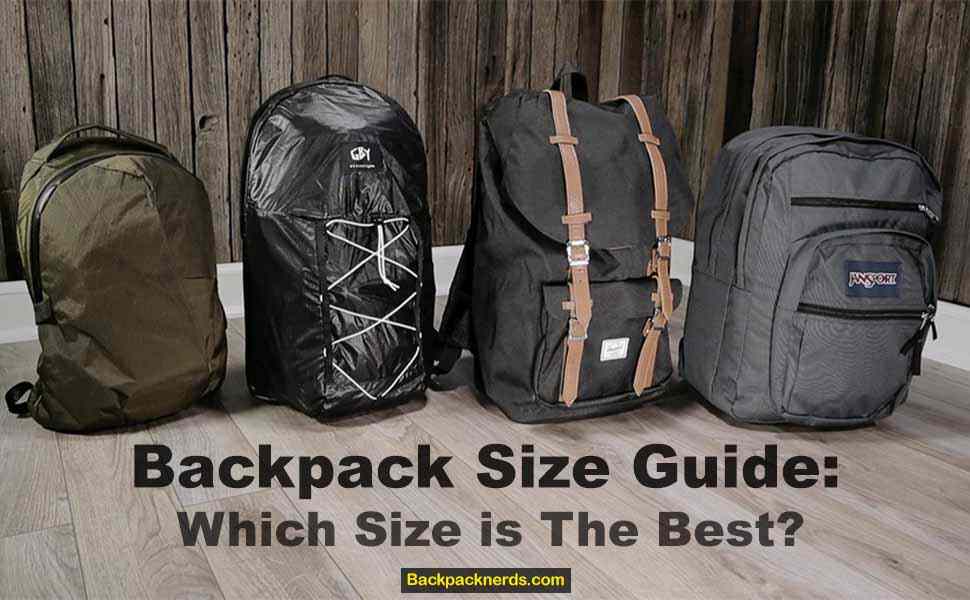Welcome to our Backpack Size Guide, where we will be discussing everything you need to know about choosing the right size backpack for your outdoor adventures. Backpacks come in a wide range of sizes, from small daypacks to large expedition packs, and it can be overwhelming to choose the right one for your needs. Whether you’re planning a day hike, a multi-day backpacking trip, or a travel adventure, having the right size backpack is essential for carrying your gear comfortably and efficiently. In this guide, we will provide an overview of backpack sizes, with a focus on backpacks between 19 liters to 40 liters, and help you choose the best size backpack for your needs. So let’s dive in and discover the perfect backpack for your next adventure!
What Measurement System Is Followed To Measure A Backpack?
The most common measurement system used to measure a backpack is the metric system. Backpack dimensions are typically measured in centimeters (cm) or liters (L) in order to provide accurate information about the size and capacity of the backpack. Some backpacks may also have measurements listed in inches (in) or cubic inches (cu in), which are part of the imperial system of measurement, but this is less common. It’s important to note that different brands and manufacturers may have slightly different ways of measuring their backpacks, so it’s always a good idea to check the specific measurements provided by the manufacturer before making a purchase.
Backpack Capacity Explained
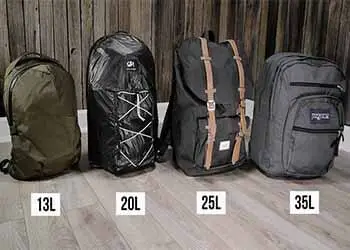
Backpack capacity refers to the volume of space that the backpack can hold. In another word, it refers to the volume of the backpack’s main compartment, and it is usually measured in liters (L) or cubic inches (cu in). The capacity of a backpack is an important consideration when choosing a backpack, as it determines how much gear you can carry.
The capacity of a backpack can vary widely depending on the type and intended use of the backpack.
Here are some general guidelines for backpack capacity:
| Backpacks Type | Capacity in Liters |
|---|---|
| Hydration backpacks | 1-3 liters |
| Daypack backpacks | 10-35 liters |
| School backpacks | 20-40 liters |
| Tactical backpacks | 20-60 liters |
| Rolling backpacks | 20-40+ liters |
| Hiking backpacks | 35-70 liters |
| Travel backpacks | 35-80+ liters |
It’s important to note that the capacity of a backpack is not the only factor to consider when choosing a backpack. The design, fit, and features of the backpack are also important considerations, as they can affect the comfort and functionality of the backpack. Additionally, it’s important to choose a backpack that is appropriate for the specific activity or use, as different types of backpacks are designed for different purposes.
Why A Backpack Over 40l Is Not An Ideal Choice For Daily Use?
In this article, backpack size guide, we will only discuss those backpacks that are over 19Liters and under 40Liters because above 40L backpacks are not great for daily use. So, why a backpack above 40l is not great for everyday use?
Well, a 40-liter backpack may not be the most practical choice for daily use due to its size and weight. It can be cumbersome to carry around for extended periods, especially if it’s fully loaded. The large size can also lead to overpacking, making the backpack unnecessarily heavy and uncomfortable. It can be challenging to keep a 40-liter backpack organized due to its size, and its bulky appearance may not be suitable for professional or formal settings. For everyday use, a smaller, more compact backpack may be a better choice, as it’s more manageable, organized, and professional-looking.
Related Articles:
- Luggage Size Guide
- How Big is a 20 Liter Backpack?
- How Big is a 30 Liter Backpack?
- How Big is a 40 Liter Backpack?
General Categorization of Backpacks
While backpack capacity can be measured in either cubic inches (in³) or liters (L), most backpacks are measured in liters. We’re going to focus on measuring it in liters. When choosing a backpack, always consider its size. You’ll find that there are many backpack manufacturers who create smaller-sized bags.
Backpacks usually come in different sizes, and this is a general guide to the size of your backpack. For the sake of simplicity, we like to divide backpacks into simpler size categories of Small, Medium, Large, and Extra-Large to make anyone understand in an easier way. These unofficial and general intended categories are:
- Small Backpacks (Under 19L)
- Medium Backpacks (20-29L)
- Large Backpacks (30-39L)
- Extra-Large Backpacks (40-80+)
Note that these categories are just how we categorize backpacks, and they certainly are not meant to be a universal way to determine backpack size.
Let’s now discuss those backpack sizes one by one.
Small Backpacks (Under 19L)
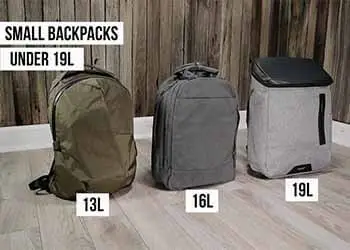
Backpacks under 19 liters are best used for carrying essentials and small items, such as a water bottle, wallet, phone, keys, and a few other items. They are typically small, compact, and lightweight, making them ideal for activities where you need to move quickly and lightly, such as day hikes, cycling, commuting, or running errands around town.
Backpacks of this size are also great for use as a personal item on flights, as they can fit under the seat in front of you and can carry all the essentials you need for a short flight. Additionally, they are suitable for students who need to carry a few books or a laptop and other small items to class.
Small Backpacks that are under 19 liters are best used for:
- Essential daily carry (keys, water bottle, sunglasses, and other small items)
- Tech carry (laptop, tablet, and accessories)
- Travel day bags
Overall, backpacks under 19 liters are a versatile option that can be used for a variety of activities and situations, where you don’t need to carry a lot of items. They are practical, easy to carry, and often come in stylish designs that make them a popular choice for everyday use.
What Fits Inside A 13l Backpack?
A 13L backpack is a small and compact backpack that is ideal for carrying just the essentials. Here are some examples of what can fit inside a 13L backpack:
- Small laptop or tablet
- A pair of clothes
- Toiletries
- Snacks or a light lunch
- Water bottle
- Wallet, phone, keys
- Books or notebooks
- Lightweight jacket or raincoat
Please note that the specific items that can fit inside a 13L backpack can vary depending on their size and shape.
What Fits Inside A 16l Backpack?
A 16L backpack is a small and compact backpack that is slightly larger than a 13L backpack, but still ideal for carrying just the essentials. Here are some examples of what can fit inside a 16L backpack:
- Up to 13” laptop or tablet
- 2x 1-inch binders
- A change of clothes (such as a shirt, a pair of pants, and underwear)
- Toiletries (such as toothbrush, toothpaste, and face wash)
- Snacks or a light lunch
- Water bottle
- Wallet, phone, keys, and other small essentials
- Books or notebooks
- Lightweight jacket or raincoat
- Sunglasses and hat
Depending on their size and shape, specific items that can fit inside a 16L backpack can vary. It’s important to choose the right size backpack for the items you plan to carry to ensure that everything fits comfortably.
Pros and Cons of Small Backpacks (Under 19L)
A 19-liter or a backpack under 19L has some advantages and disadvantages. Let’s find out what they are:
| Pros |
|---|
| + Lightweight and easy to carry + Ideal for short trips and day trips + Forces you to pack only essential items + Compact size makes it easy to maneuver in crowded spaces + Encourages minimalism and efficient packing + Can be used for a variety of activities such as hiking, biking, and sightseeing + Less bulky than larger backpacks |
| Cons |
|---|
| – Limited capacity for carrying items – Cannot accommodate larger items such as laptops and textbooks – May not be comfortable for extended periods of time |
Overall, small backpacks under 19L are great for individuals who want a lightweight and compact backpack for short trips or day-to-day activities. However, they may not be suitable for individuals who need to carry a lot of gear or for extended periods of time.
Some Small Backpacks under 19 Liters That You May Like –
Medium Backpacks (20-29L)
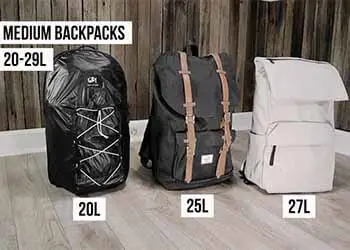
Medium backpacks, typically ranging from 20 to 29 liters, offer more storage space than small backpacks while still remaining relatively compact and easy to carry. They are suitable for a variety of activities such as day hikes, short trips, school or work commutes, and traveling. With their slightly larger size, they can accommodate the following items:
Medium-sized backpacks are a versatile choice that offers a good balance between storage capacity and portability. They are a popular choice for people who need a little more space than what a small backpack can offer but don’t want to carry a larger backpack that may be too bulky or heavy.
Medium size backpacks, or those that hold anything from 20 to 29 liters, are the Goldilocks of backpacks. In another word, the most comfortable backpacks for most people are medium size backpacks that are between 20-29 liters.
Backpack size varies, but you’ll usually find the medium size to be ideal for most people.
Backpacks that are between 20-29L are best used for:
- School and college
- Camera backpacks
- Work and gym backpacks
What Fits Inside A 20l Backpack?
A 20L backpack can typically hold the following items:
- Small laptop or tablet
- Books or notepads
- Light jacket or sweater
- Water bottle or hydration system
- Sunglasses or hat
- Wallet and phone
- Keys or other small accessories
- Travel-sized toiletries
- Portable charger
- Earbuds or headphones
- A small camera or GoPro
- Map or guidebook
It’s important to note that the exact amount and type of items that can fit in a 20L backpack may vary depending on the shape and design of the backpack, as well as the size of the items themselves.
What Fits Inside A 25l Backpack?
The 25l backpack is a great backpack. It falls in between 20 liters and 29 liters backpack that is also under Medium size backpack. A 25L backpack can typically hold the following items:
- Small laptop or tablet
- Small Books or notepads
- Water bottle or hydration system
- Small first aid kit
- Sunglasses or hat
- Wallet and phone
- Travel-sized toiletries
- Portable charger
- Earbuds or headphones
- Small camera or GoPro
- Compact sleeping bag or travel pillow
- Lightweight tent or hammock
- Trekking poles or walking sticks
- Trail mix or other lightweight camping food
Again, the specific items that can fit inside a 25L backpack may vary depending on the backpack’s design and the size of the items themselves. It’s important to test out your backpack with your specific items before embarking on a trip.
Pros and Cons of Medium Backpacks (20-29L)
Medium-sized backpacks in the 20-29L range are a good choice for individuals who need a bit more space than a small backpack but do not want to carry a bulky, large backpack. They do have cons besides pros. Let’s find out.
| Pros |
|---|
| + Adequate capacity for carrying items + Can accommodate laptops and textbooks + Has organizational features for better packing + Provides enough support for moderate loads + Suitable for a range of activities, including day hikes and short trips + Comfortable fit for extended periods of time + Can be used as a carry-on for flights |
| Cons |
|---|
| – May be too large for individuals with smaller body frames – Can become heavy when fully loaded – May not have specialized features for specific activities such as skiing or cycling |
The 20L-29L range backpacks offer adequate capacity and organizational features for efficient packing, as well as enough support for moderate loads. However, they may be too large for some individuals and can become heavy when fully loaded. It is important to consider your needs and preferences when selecting a backpack.
Some Medium Backpacks (20-29L) That You May Like –
Large Backpacks (30-39L)
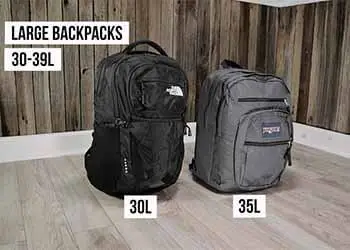
Large backpacks with a capacity of 30-39L are ideal for day hikes, overnight trips, and weekend getaways. They offer ample space for essentials such as water, snacks, extra clothes, and a sleeping bag. They are also suitable for urban commutes and college students who need to carry a laptop and books. Look for backpacks with comfortable straps, padded back panels, and multiple compartments for easy organization.
Large Size Backpacks 30-39L are best used for:
- Extra-large school backpacks (multiple large textbooks)
- Travel backpacks (weekend and carry-on)
- Large laptops (17” and 18”)
What Fits Inside A 30l Backpack?
A 30L backpack can hold all the necessary items for a day trip or short hike. It’s suitable for carrying a change of clothes, toiletries, snacks, water bottle, electronics, and some essential gear.
Here are some items that could fit inside a 30L backpack:
- Up to 15” Laptop
- Clothes for a day trip
- Water bottle
- Camera or other small electronics
- Map and compass
- First aid kit
- Wallet, keys, and phone
- Toiletries
- Sunglasses and hat
- Umbrella or rain jacket
- A small book or notepad.
A 30L backpack can typically fit a day’s worth of essentials. However, the exact items that can fit will depend on their size and the design of the backpack.
What Fits Inside A 35l Backpack?
A 35L backpack can generally hold more items than a 30L backpack, making it suitable for day trips or overnight stays. It can typically fit a change of clothes, toiletries, a sleeping bag, a small tent, food and water, and some additional gear.
A 35L backpack can hold a variety of items for day trips or overnight stays, such as:
- Up to 15” Laptop
- 2x hoodies or sweaters
- Small book
- 2x 1-inch binders
- DSLR camera insert
- Large textbook
- A change of clothes
- Toiletries
- Sleeping bag
- Small tent
- Water bottle
- A first-aid kit
- Hiking poles
Again, the exact items that can fit will depend on their size and the design of the backpack. Some 35L backpacks may have specialized compartments or features that allow for more efficient packing and organization.
Pros and Cons of Large Backpacks (30-39L)
Large backpacks in the 30-39L range are a good choice for individuals who need to carry a lot of gear or are planning longer trips. Besides its advantages, the 30L-39L range backpacks have disadvantages too. Let’s learn about them.
| Pros |
|---|
| + Plenty of capacity for carrying items + Can accommodate larger items such as tents and sleeping bags + Offers plenty of organizational features for efficient packing + Provides enough support for heavier loads + Suitable for a range of activities, including longer hikes and trips + Can be used as a carry-on for flights + Offers specialized features for specific activities such as skiing or cycling |
| Cons |
|---|
| – Could be too large and bulky for some individuals – Can be more expensive than smaller backpacks – Might be more difficult to maneuver in crowded spaces |
The 30-39L range offers plenty of capacity and organizational features for efficient packing, as well as enough support for heavier loads. However, they may be too large and bulky for some individuals and can become heavy when fully loaded. They are also not suitable for day-to-day use or for individuals with smaller body frames. It is important to consider your needs and preferences when selecting a backpack.
Some Large Backpacks (30-39L) That You May Like –
Read More Articles:
- Spinner Vs Roller Luggage
- Hardside Vs Softside Luggage
- How To Measure Luggage
- Luggage Size Guide
- Backpack Checked Luggage
Extra-Large Backpacks (40-80+)

Extra-large backpacks, also known as 40-80+ liter backpacks, are designed for hikers, travelers, and backpackers who need to carry a significant amount of gear for extended trips. With ample storage space and organizational compartments, these backpacks offer comfortable and convenient solutions for carrying everything from camping gear to clothing and food. They are typically made from durable materials, such as high-quality nylon or polyester, and feature adjustable straps and padded back panels for comfort during long hauls. Additionally, some models may have specialized features, such as hydration systems and removable daypacks, to enhance their versatility and functionality.
Extra-Large Backpacks (40-80+) are best used for:
- Extended outdoor trips
- Backpacking
- Mountaineering
- Camping
- Hiking
- Multi-day hikes
What Fits Inside A 40-50l Backpack?
A 40-50 liter backpack provides ample space for carrying essential items for a variety of outdoor activities. Here are some examples of what can fit inside a 40-50 liter backpack:
- Clothing: A couple of sets of clothes, including a waterproof jacket, a fleece, a couple of pairs of socks, and underwear.
- Sleeping gear: A sleeping bag, a sleeping pad, and a pillow.
- Food and water: A water bottle or hydration system, snacks, and meals for the duration of the trip.
- Cooking gear: A portable stove, a fuel canister, a pot, a utensil set, and a lighter.
- Navigation gear: A map, a compass, and a GPS device.
- First aid kit: Including bandages, antiseptics, pain relievers, and any necessary prescription medication.
- Electronics: A headlamp, spare batteries, a camera, and a power bank.
- Personal items: Sunscreen, insect repellent, toiletries, and a small towel.
Note that the specific items you will need to pack will depend on the nature and duration of your trip, as well as your personal preferences and requirements. It’s always a good idea to make a detailed list of everything you need to bring and double-check it before heading out on your adventure.
What Fits Inside A 50-60l Backpack?
A 50-60 liter backpack provides more space than a 40-50 liter backpack, making it suitable for longer trips or for carrying more specialized equipment. Here are some examples of what can fit inside a 50-60 liter backpack:
- Clothing: Multiple sets of clothes, including waterproof and warm layers, several pairs of socks and underwear.
- Sleeping gear: A larger sleeping bag, a sleeping pad, a tent or a hammock, and a pillow.
- Food and water: A hydration system, meals and snacks for the duration of the trip, and cooking utensils.
- Cooking gear: A portable stove, a fuel canister, a pot, a frying pan, a utensil set, and a lighter.
- Navigation gear: A map, a compass, and a GPS device.
- First aid kit: Including bandages, antiseptics, pain relievers, and any necessary prescription medication.
- Electronics: A headlamp, spare batteries, a camera, a tripod, and a power bank.
- Personal items: Sunscreen, insect repellent, toiletries, a quick-drying towel, and a book or a journal.
Remember, the specific items you will need to pack will depend on the nature and duration of your trip, as well as your personal preferences and requirements. It’s important to pack only what you need and avoid overpacking, as this can make your backpack heavier and more difficult to carry over long distances.
What Fits Inside A 60-80l Backpack?
A 60-80 liter backpack provides even more space than a 50-60 liter backpack, making it suitable for extended trips or for carrying bulkier gear. Here are some examples of what can fit inside a 60-80 liter backpack:
- Clothing: Multiple sets of clothes, including waterproof and warm layers, several pairs of socks, and underwear.
- Sleeping gear: A larger sleeping bag, a sleeping pad, a tent or a hammock, and a pillow.
- Food and water: A hydration system, meals and snacks for the duration of the trip, and cooking utensils.
- Cooking gear: A portable stove, a fuel canister, a pot, a frying pan, a utensil set, and a lighter.
- Navigation gear: A map, a compass, and a GPS device.
- First aid kit: Including bandages, antiseptics, pain relievers, and any necessary prescription medication.
- Electronics: A headlamp, spare batteries, a camera, a tripod, a power bank, and a solar charger.
- Personal items: Sunscreen, insect repellent, toiletries, a quick-drying towel, a book or a journal, and a small packable chair.
In addition, a 60-80 liter backpack provides enough space to carry specialized gear, such as climbing equipment, diving gear, or snowshoes, depending on the nature of the trip. However, as with any backpack, it’s important to pack only what you need and avoid overpacking to keep the weight of the backpack manageable and comfortable to carry over long distances.
What Fits Inside A 80+L Backpack?
An 80+ liter backpack provides a lot of space and is typically used for extended expeditions or trips that require carrying large and bulky equipment. Here are some examples of what can fit inside an 80+ liter backpack:
- Clothing: Multiple sets of clothes, including waterproof and warm layers, several pairs of socks and underwear.
- Sleeping gear: A larger and more insulated sleeping bag, a sleeping pad, a tent or a hammock, and a pillow.
- Food and water: A hydration system, meals and snacks for the duration of the trip, and cooking utensils.
- Cooking gear: A portable stove, a fuel canister, a pot, a frying pan, a utensil set, and a lighter.
- Navigation gear: A map, a compass, and a GPS device.
- First aid kit: Including bandages, antiseptics, pain relievers, and any necessary prescription medication.
- Electronics: A headlamp, spare batteries, a camera, a tripod, a power bank, and a solar charger.
- Personal items: Sunscreen, insect repellent, toiletries, a quick-drying towel, a book or a journal, and a small packable chair.
In addition, an 80+ liter backpack can carry larger and more specialized equipment, such as mountaineering gear, scuba diving equipment, or winter sports gear. However, as with any backpack, it’s important to pack only what you need and avoid overpacking to keep the weight of the backpack manageable and comfortable to carry over long distances.
Pros and Cons of Extra-Large Backpacks (40-80+)
| Pros |
|---|
| + Large capacity + Versatile and Comfortable + Organizational features + Sturdy and Durable + Suitable for extended trips + Well-padded back panel + Suitable for extended trips + Can carry specialized equipment + Can accommodate winter gear + Good for distributing weight evenly |
| Cons |
|---|
| – Heavy & bulky size – Expensive – Risk of overpacking – May not fit in overhead compartments |
Extra-large backpacks (40-80+) can be a great option for those who need to carry a lot of gear or specialized equipment on extended trips. They offer a large capacity and often come with comfort and organizational features. However, they can be bulky, heavy, and expensive, with a risk of overpacking. Ultimately, the decision to use an extra-large backpack comes down to individual needs and preferences.
Some Extra-Large Backpacks (40-80+) That You May Like –
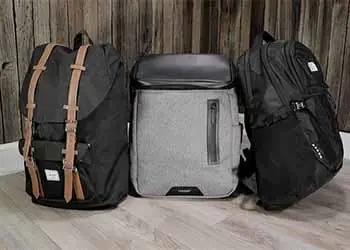
Backpack Size Guide Table
The backpack size guide table is a useful tool for selecting the appropriate backpack size for different types of activities. It provides a general overview of the recommended backpack capacity and use, based on the length of the trip or activity. By following this guide, individuals can choose a backpack that fits their needs and allows them to carry all the necessary items comfortably. However, it’s important to keep in mind that the guide is not absolute and may vary depending on personal preferences and the backpack’s specific features and design.
So, let’s know the backpack size guide table here.
| Size | Dimensions | Capacity (cubic inches) |
| 15 L Backpack | 18.4 x 11.2 x 1.6 inches | 915.356 |
| 18 L Backpack | 9.06 x 6.69 x 16.54 inches | 1098.43 |
| 20 L Backpack | 19 x 13 x 1.5 inches | 1220.47 |
| 21 L Backpack | 17.5 x 11 x 5.5 inches | 1281.5 |
| 25 L Backpack | 17.56 x 12.05 x 4.76 inches | 1525.59 |
| 30 L Backpack | 18.11 x 10.63 x 11.81 inches | 1830.71 |
| 35 L Backpack | 19.5 x 11.5 x 5.9 inches | 2135.83 |
| 40 L Backpack | 20.5 x 13 x 7.1 inches | 2440.95 |
| 45 L Backpack | 21.7*12.9*9.8 inches | 2746.07 |
| 50 L Backpack | 25 x 13 x 12 inches | 3356.31 |
| 55 L backpack | 26 x 14.25 x 4.5 inches | 3661.42 |
| 60 L backpack | 26.77 x 13 x 7.87 inches | 3661.42 |
Now, we will learn what size backpack is called what and what purposes they are used for. The backpack capacity is based on the backpack size. You can get a backpack from 10L to 80L, basically according to your needs. However, let’s see the backpack size, capacity, and purpose using a table.
| Backpack Size | Capacity | Recommended Use |
| 10-20L | Daypack | Short hikes, bike rides, or everyday use |
| 25-35L | Overnight | Day hikes, overnight camping, or travel |
| 40-50L | Weekend | Weekend camping or travel, multi-day hikes |
| 50-65L | Extended trips | Extended camping or travel, multi-day hikes with camping gear |
| 70L+ | Expedition | Expeditions, long backpacking trips with extensive gear |
Please note that this is a general guide, and recommended use may vary depending on the individual’s needs, the specific backpack design, and the items being packed. So, you must check the specifications of the backpack before buying it.
Frequently Asked Questions:
How Big is a 15 Liter Backpack?
A 15 liter backpack is small in size, with dimensions around 15-17 inches in height, 10-12 inches in width, and 5-7 inches in depth. It can hold around 2-3 days’ worth of essential items and is ideal for day trips or short hikes.
How Big is a 20 Liter Backpack?
A 20 liter backpack is typically medium in size, with dimensions around 18-20 inches in height, 12-14 inches in width, and 6-8 inches in depth. It can hold around 3-4 days’ worth of essential items and is suitable for day trips, short hikes, or commuting to work or school.
How Big is a 25 Liter Backpack?
A 25 liter backpack is a medium-sized backpack that measures around 20-22 inches in height, 12-14 inches in width, and 8-10 inches in depth. It can hold approximately 4-5 days’ worth of essential items and is suitable for day trips, weekend getaways, or as a daypack for longer hikes.
How Big is a 30 Liter Backpack?
A 30 liter backpack is typically large in size, with dimensions around 22-24 inches in height, 12-14 inches in width, and 10-12 inches in depth. It can hold around 5-7 days’ worth of essential items and is suitable for longer trips, camping, or as a daypack for hiking or other outdoor activities.
How Big is a 35 Liter Backpack?
A 35 liter backpack is considered a large-sized backpack and is designed to carry a substantial amount of gear. It usually has dimensions ranging from 24-26 inches in height, 12-14 inches in width, and 10-12 inches in depth, providing ample space for storage. This type of backpack is ideal for longer trips, backpacking, and carrying larger items such as camera equipment or extra layers. It can hold approximately 7-10 days’ worth of essential items, making it perfect for outdoor enthusiasts who require more space for their gear.
How Big is a 45 Liter Backpack?
A 45 liter backpack is an extra-large backpack that measures around 26-28 inches in height, 12-14 inches in width, and 10-12 inches in depth. It can hold approximately 10-14 days’ worth of essential items and is ideal for extended trips or backpacking, as well as carrying bulky or heavy items such as camping gear or photography equipment.
How Big is a 55 Liter Backpack?
A 55 liter backpack is a larger backpack that typically measures around 28-30 inches in height, 12-14 inches in width, and 10-12 inches in depth. It has a capacity of approximately 14-21 days’ worth of essential items, making it suitable for longer trips or backpacking adventures. This type of backpack provides ample space for storing larger items such as tents, sleeping bags, or cookware. Its size and capacity allow for better weight distribution and comfort, making it easier to carry for extended periods.
How Big is a 65 Liter Backpack?
A 65 liter backpack is an extra-large backpack that typically measures around 30-32 inches in height, 12-14 inches in width, and 10-12 inches in depth. It has a capacity of approximately 21-28 days’ worth of essential items, making it ideal for extended trips or backpacking adventures. This type of backpack provides ample space for storing larger items such as tents, sleeping bags, or cookware. It also has features such as an adjustable suspension system for better weight distribution and comfort during long hikes.
How Big is a 70 Liter Backpack?
A 70 liter backpack has a volume capacity of 70 liters or approximately 4,270 cubic inches. It is an extra-large backpack that measures around 32-34 inches in height, 12-14 inches in width, and 10-12 inches in depth. It has a capacity of approximately 23-30 days’ worth of essential items, making it suitable for extended backpacking trips or expeditions. This type of backpack is designed to carry heavier and bulkier items, such as tents, sleeping bags, and climbing gear. Its larger size provides more space for storage and weight distribution, making it comfortable to carry for extended periods.
How large is an 80 Liter Backpack?
The exact dimensions of an 80 liter backpack can vary depending on the design and manufacturer. However, it typically has a volume capacity of 80 liters or approximately 4,880 cubic inches, which translates to roughly 30-35 inches in height, 15-20 inches in width, and 10-15 inches in depth.
The size of an 80 liter backpack makes it suitable for multi-day trips or extended travel where you may need to carry a lot of gear and supplies. It can comfortably hold a sleeping bag, tent, cooking equipment, clothing, and other essentials needed for a longer trip. However, it’s important to keep in mind that the size and weight of each item will determine the actual amount of items you can pack into the backpack.
Final Words
In conclusion, choosing the right size backpack is crucial for a comfortable and enjoyable experience when carrying your gear and supplies. Backpacks ranging from 19 liters to 40 liters are typically suitable for day hikes, commuting, and short trips. They are lightweight and compact, making them easy to carry and maneuver. However, it’s important to consider the specific needs of your trip and the items you will need to carry before selecting a backpack size. Factors such as the duration of the trip, the type of activities planned, and the weather conditions should be taken into account when making your choice. By following this backpack size guide and taking into consideration your specific needs, you can ensure that you have the right size backpack for your next adventure.
Read More Articles:
- Best North Face Backpacks For Travelers
- Can You Wash A North Face Backpack
- Basic Bushcraft Gear
- Best Bushcraft Backpack With Axe Holder
- Best Range Backpacks And Review Guide
- Largest Luggage Size For Check-In
- How To Protect Luggage From Theft
- How To Clean Fabric Luggage
Image Credit: Backpackies

